调整.NET控件WebBrowser的默认浏览器内核版本
2017-05-12 16:52
302 查看
摘要: 调整.NET控件WebBrowser的默认浏览器内核版本
今天在调试程序的时候,需要使用C#的客户端远程登录一个Web页面,用到了WebBrowser控件。但是却发现了一件很神奇的事情:
当前浏览器使用的内核,可以通过访问下面这个网站获取:http://ie.icoa.cn/
我的IE版本为IE8,在使用IE登录页面的时候,使用的内核是IE8,登录该网站的截图如下:
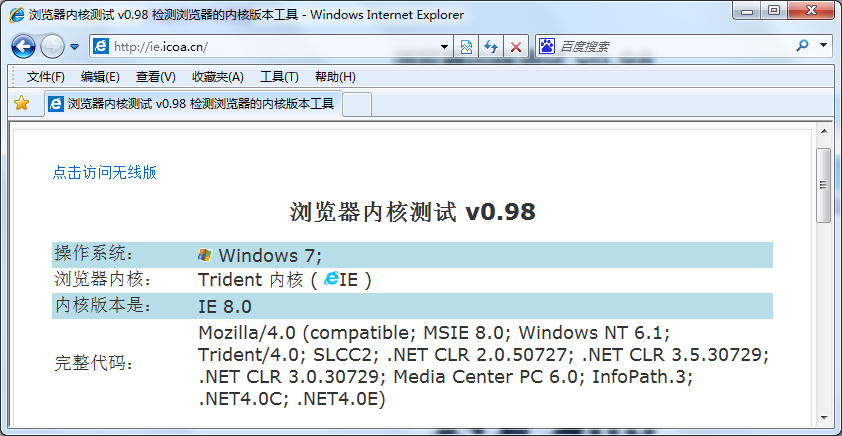
但是当我用WebBrowser登录该页面时,显示使用的内核却是IE7:
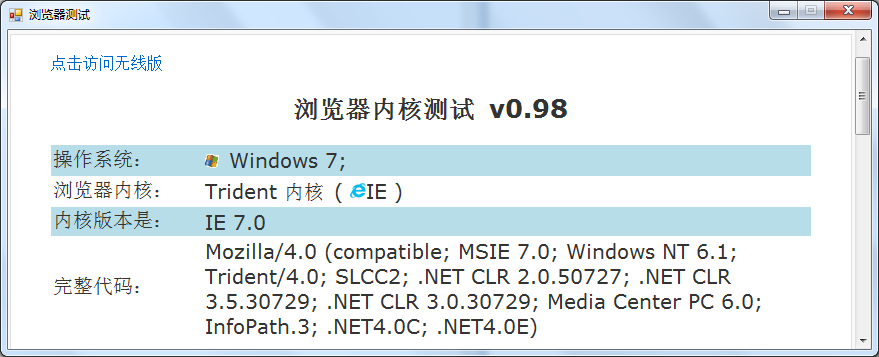
上图的程序是一个测试程序,仅包含一个WebBrowser,这个程序的名称是TestWebBrowser.exe。可以发现,虽然同为Trident内核,但在WebBrowser控件中使用的内核版本却与IE不一样,这让我感到疑惑。因为我要登录的页面是针对IE8以上版本开发的,因此我需要尝试让程序内的WebBrowser以IE8的内核登录网页。
在网上找了一些资料后,我发现可以通过下面这个办法来解决:
1、在开始菜单内输入“regedit.exe”,进入注册表编辑器
2、找到注册表项:HKEY_LOCAL_MACHINE\SOFTWARE\Microsoft\Internet Explorer\MAIN\FeatureControl\FEATURE_BROWSER_EMULATION
3、在右侧空白区域内单击鼠标右键,点击【新建】→【DWORD(32-位)值】
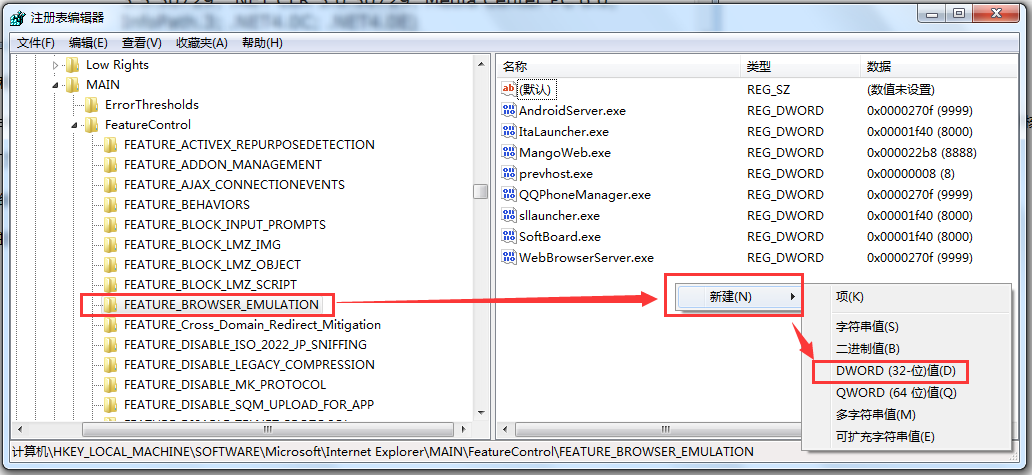
4、新建的项取名为TestWebBrowser.exe,编辑值时,选择基数“十进制”,填写数值数据,这里填写8888

5、这个时候再进入Debug目录下生成好的TestWebBrowser,可以看到登录的内核版本变成IE8了!
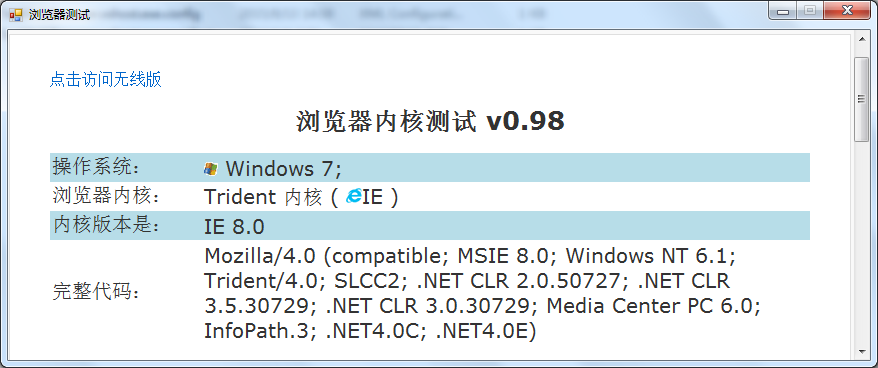
需要注意的是,在VS内以调试的方法进入程序,打开的程序实际上是TestWebBrowser.vshost.exe,并不能看到效果,必须要打开Debug目录下的TestWebBrowser.exe,才能发现内核版本的改变。之前WebBrowser使用IE7内核的原因,就是.NET中的WebBrowser控件默认使用了IE7兼容性模式来浏览网页。
一一一一一一一一一分割线一一一一一一一一一
上面这个方法依靠修改注册表来完成WebBrowser使用内核的变更,不过光知道新建一个注册表项并把值设置为“8888”还远远不够,本着“知其然还要知其所以然”的想法,我查阅了相关的MSDN页面:https://msdn.microsoft.com/en-us/library/ee330730%28v=vs.85%29.aspx
这个页面的标题是:Internet Feature Controls (B..C),即互联网功能控制,我们要找的章节是“Browser Emulation”(浏览器仿真)。原来自从IE8以后,在注册表中添加了FEATURE_BROWSER_EMULATION功能,这个功能是用来定义IE默认的仿真模式。
这个功能在注册表中的位置如下:
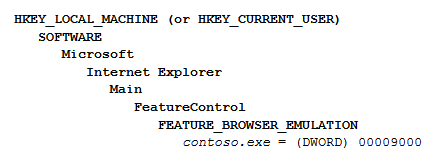
该注册表项的各可能取值描述如下(原文见MSDN,纯手工翻译,如有不足之处欢迎指出)
7000 (0x1B58)
Webpages containing standards-based !DOCTYPE directives are displayed in IE7 Standards mode. Default value for applications hosting the WebBrowser Control.
包含标准!DOCTYPE指令的页面将会以IE7兼容模式打开。WebBrowser控件的默认值。
8000 (0x1F40)
Webpages containing standards-based !DOCTYPE directives are displayed in IE8 mode. Default value for Internet Explorer 8
Important In Internet Explorer 10, Webpages containing standards-based !DOCTYPE directives are displayed in IE10 Standards mode.
包含标准!DOCTYPE指令的页面将会以IE8兼容模式打开,IE8浏览器的默认值。对于IE10来说,包含标准!DOCTYPE指令的页面会以IE10兼容模式打开。
8888 (0x22B8)
Webpages are displayed in IE8 Standards mode, regardless of the declared !DOCTYPE directive. Failing to declare a !DOCTYPE directive causes the page to load in Quirks.
无论是否声明!DOCTYPE指令,页面以IE8兼容模式打开。对于未正确声明!DOCTYPE指令的页面,将会以怪异模式(quirks mode)加载。
9000 (0x2328)
Internet Explorer 9. Webpages containing standards-based !DOCTYPE directives are displayed in IE9 mode. Default value for Internet Explorer 9.
Important In Internet Explorer 10, Webpages containing standards-based !DOCTYPE directives are displayed in IE10 Standards mode.
IE9,包含标准!DOCTYPE指令的页面将会以IE9兼容模式打开,IE9浏览器的默认值。对于IE10来说,包含标准!DOCTYPE指令的页面会以IE10兼容模式打开。
9999 (0x270F)
Windows Internet Explorer 9. Webpages are displayed in IE9 Standards mode, regardless of the declared !DOCTYPE directive. Failing to declare a !DOCTYPE directive causes the page to load in Quirks.
IE9,无论是否声明!DOCTYPE指令,页面以IE9兼容模式打开。对于未正确声明!DOCTYPE指令的页面,将会以怪异模式(quirks mode)加载。
10000 (0x02710)
Internet Explorer 10. Webpages containing standards-based !DOCTYPE directives are displayed in IE10 Standards mode. Default value for Internet Explorer 10.
IE10,包含标准!DOCTYPE指令的页面将会以IE10兼容模式打开,IE10浏览器的默认值。
10001 (0x2711)
Internet Explorer 10. Webpages are displayed in IE10 Standards mode, regardless of the !DOCTYPE directive.
IE10,无论是否声明!DOCTYPE指令,页面以IE10兼容模式打开。
11001 (0x2AF9)
IE11. Webpages containing standards-based !DOCTYPE directives are displayed in IE11 edge mode. Default value for IE11.
IE11,包含标准!DOCTYPE指令的页面将会以IE11兼容模式打开,IE11浏览器的默认值。
11000 (0x2AF8)
Internet Explorer 11. Webpages are displayed in IE11 edge mode, regardless of the declared !DOCTYPE directive. Failing to declare a !DOCTYPE directive causes the page to load in Quirks.
IE11,无论是否声明!DOCTYPE指令,页面将会以IE11的edge模式打开。对于未正确声明!DOCTYPE指令的页面,将会以怪异模式(quirks mode)加载。
END
今天在调试程序的时候,需要使用C#的客户端远程登录一个Web页面,用到了WebBrowser控件。但是却发现了一件很神奇的事情:
当前浏览器使用的内核,可以通过访问下面这个网站获取:http://ie.icoa.cn/
我的IE版本为IE8,在使用IE登录页面的时候,使用的内核是IE8,登录该网站的截图如下:

但是当我用WebBrowser登录该页面时,显示使用的内核却是IE7:

上图的程序是一个测试程序,仅包含一个WebBrowser,这个程序的名称是TestWebBrowser.exe。可以发现,虽然同为Trident内核,但在WebBrowser控件中使用的内核版本却与IE不一样,这让我感到疑惑。因为我要登录的页面是针对IE8以上版本开发的,因此我需要尝试让程序内的WebBrowser以IE8的内核登录网页。
在网上找了一些资料后,我发现可以通过下面这个办法来解决:
1、在开始菜单内输入“regedit.exe”,进入注册表编辑器
2、找到注册表项:HKEY_LOCAL_MACHINE\SOFTWARE\Microsoft\Internet Explorer\MAIN\FeatureControl\FEATURE_BROWSER_EMULATION
3、在右侧空白区域内单击鼠标右键,点击【新建】→【DWORD(32-位)值】

4、新建的项取名为TestWebBrowser.exe,编辑值时,选择基数“十进制”,填写数值数据,这里填写8888

5、这个时候再进入Debug目录下生成好的TestWebBrowser,可以看到登录的内核版本变成IE8了!

需要注意的是,在VS内以调试的方法进入程序,打开的程序实际上是TestWebBrowser.vshost.exe,并不能看到效果,必须要打开Debug目录下的TestWebBrowser.exe,才能发现内核版本的改变。之前WebBrowser使用IE7内核的原因,就是.NET中的WebBrowser控件默认使用了IE7兼容性模式来浏览网页。
一一一一一一一一一分割线一一一一一一一一一
上面这个方法依靠修改注册表来完成WebBrowser使用内核的变更,不过光知道新建一个注册表项并把值设置为“8888”还远远不够,本着“知其然还要知其所以然”的想法,我查阅了相关的MSDN页面:https://msdn.microsoft.com/en-us/library/ee330730%28v=vs.85%29.aspx
这个页面的标题是:Internet Feature Controls (B..C),即互联网功能控制,我们要找的章节是“Browser Emulation”(浏览器仿真)。原来自从IE8以后,在注册表中添加了FEATURE_BROWSER_EMULATION功能,这个功能是用来定义IE默认的仿真模式。
这个功能在注册表中的位置如下:

该注册表项的各可能取值描述如下(原文见MSDN,纯手工翻译,如有不足之处欢迎指出)
7000 (0x1B58)
Webpages containing standards-based !DOCTYPE directives are displayed in IE7 Standards mode. Default value for applications hosting the WebBrowser Control.
包含标准!DOCTYPE指令的页面将会以IE7兼容模式打开。WebBrowser控件的默认值。
8000 (0x1F40)
Webpages containing standards-based !DOCTYPE directives are displayed in IE8 mode. Default value for Internet Explorer 8
Important In Internet Explorer 10, Webpages containing standards-based !DOCTYPE directives are displayed in IE10 Standards mode.
包含标准!DOCTYPE指令的页面将会以IE8兼容模式打开,IE8浏览器的默认值。对于IE10来说,包含标准!DOCTYPE指令的页面会以IE10兼容模式打开。
8888 (0x22B8)
Webpages are displayed in IE8 Standards mode, regardless of the declared !DOCTYPE directive. Failing to declare a !DOCTYPE directive causes the page to load in Quirks.
无论是否声明!DOCTYPE指令,页面以IE8兼容模式打开。对于未正确声明!DOCTYPE指令的页面,将会以怪异模式(quirks mode)加载。
9000 (0x2328)
Internet Explorer 9. Webpages containing standards-based !DOCTYPE directives are displayed in IE9 mode. Default value for Internet Explorer 9.
Important In Internet Explorer 10, Webpages containing standards-based !DOCTYPE directives are displayed in IE10 Standards mode.
IE9,包含标准!DOCTYPE指令的页面将会以IE9兼容模式打开,IE9浏览器的默认值。对于IE10来说,包含标准!DOCTYPE指令的页面会以IE10兼容模式打开。
9999 (0x270F)
Windows Internet Explorer 9. Webpages are displayed in IE9 Standards mode, regardless of the declared !DOCTYPE directive. Failing to declare a !DOCTYPE directive causes the page to load in Quirks.
IE9,无论是否声明!DOCTYPE指令,页面以IE9兼容模式打开。对于未正确声明!DOCTYPE指令的页面,将会以怪异模式(quirks mode)加载。
10000 (0x02710)
Internet Explorer 10. Webpages containing standards-based !DOCTYPE directives are displayed in IE10 Standards mode. Default value for Internet Explorer 10.
IE10,包含标准!DOCTYPE指令的页面将会以IE10兼容模式打开,IE10浏览器的默认值。
10001 (0x2711)
Internet Explorer 10. Webpages are displayed in IE10 Standards mode, regardless of the !DOCTYPE directive.
IE10,无论是否声明!DOCTYPE指令,页面以IE10兼容模式打开。
11001 (0x2AF9)
IE11. Webpages containing standards-based !DOCTYPE directives are displayed in IE11 edge mode. Default value for IE11.
IE11,包含标准!DOCTYPE指令的页面将会以IE11兼容模式打开,IE11浏览器的默认值。
11000 (0x2AF8)
Internet Explorer 11. Webpages are displayed in IE11 edge mode, regardless of the declared !DOCTYPE directive. Failing to declare a !DOCTYPE directive causes the page to load in Quirks.
IE11,无论是否声明!DOCTYPE指令,页面将会以IE11的edge模式打开。对于未正确声明!DOCTYPE指令的页面,将会以怪异模式(quirks mode)加载。
END
相关文章推荐
- 调整.NET控件WebBrowser的默认浏览器内核版本
- C# System.Windows.Forms.WebBrowser中判断浏览器内核和版本
- 默认使用浏览器最高版本和默认使用的内核,强制竖屏
- 默认使用浏览器最高版本和默认使用的内核,强制竖屏等
- 流行浏览器内核分类及不同版本的样式区别
- 网页默认浏览器以IE那个版本查看
- Webkit内核的浏览器默认CSS属性
- Ubuntu13.10 开机启动菜单 删除多余的内核(旧版本) 调整不同操作系统的启动顺序
- Ubuntu12.10 开机启动菜单 删除多余的内核(旧版本) 调整不同操作系统的启动顺序
- js判断浏览器版本以及浏览器内核的方法
- Ubuntu11.04 开机启动菜单 删除多余的内核(旧版本) 调整不同操作系统的启动顺序
- 入门贴:利用jQuery插件扩展识别浏览器内核与外壳的类型和版本
- js获取手机浏览器内核版本
- asdm不能登录问题;浏览器必须是ie,不能是chrome或者firefox;java的版本,尤其是安全等级和例外需要调整
- Delphi WebBrowser 无法调用当前浏览器的版本
- js获取浏览器内核和版本
- 查看浏览器内核版本
- 利用jQuery插件扩展识别浏览器内核与外壳的类型和版本的实现代码
- Ubuntu12.04 开机启动菜单 删除多余的内核(旧版本) 调整不同操作系统的启动顺序
- 让android webView使用系统默认浏览器内核直接解析,不弹出选择浏览器选项
